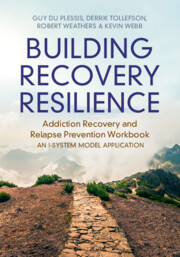 Building Recovery Resilience
Building Recovery Resilience Published online by Cambridge University Press: 28 May 2024
There is a strong link between our capacity to cope with negative emotional states and their associated negative thoughts and substance use relapse. When individuals use substances as a coping mechanism this strategy may be effective in the short term and but proves maladaptive in the long run. The use of drugs provides both negative reinforcement (namely, the reduction of painful feelings via self-medication), and positive reinforcement (that is, the pleasant experience of being high via positive outcome expectancies). The self-medication hypothesis applies when the individual is using a substance to cope with negative emotions, conflict, or stress (negative reinforcement). From a positive outcome expectancy perspective, the person is focusing on the positive aspects and euphoria of using a substance (positive reinforcement), while ignoring the negative consequences. Therefore, an essential component of recovery is learning healthy ways to self-soothe and cope with stress and painful emotions, and the negative thoughts and rumination associated with them. Without healthy coping skills, a key component of recovery capital, individuals in recovery will continue to seek dysfunctional ways to self-regulate. In this chapter the reader is introduced to one of the causes behind negative rumination and over-compensatory behaviour that accompanies it, which perpetuates the cycle of addiction.
To save this book to your Kindle, first ensure [email protected] is added to your Approved Personal Document E-mail List under your Personal Document Settings on the Manage Your Content and Devices page of your Amazon account. Then enter the ‘name’ part of your Kindle email address below. Find out more about saving to your Kindle.
Note you can select to save to either the @free.kindle.com or @kindle.com variations. ‘@free.kindle.com’ emails are free but can only be saved to your device when it is connected to wi-fi. ‘@kindle.com’ emails can be delivered even when you are not connected to wi-fi, but note that service fees apply.
Find out more about the Kindle Personal Document Service.
To save content items to your account, please confirm that you agree to abide by our usage policies. If this is the first time you use this feature, you will be asked to authorise Cambridge Core to connect with your account. Find out more about saving content to Dropbox.
To save content items to your account, please confirm that you agree to abide by our usage policies. If this is the first time you use this feature, you will be asked to authorise Cambridge Core to connect with your account. Find out more about saving content to Google Drive.